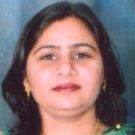
Sarita Sharma
Work place: Department of Electronics & Communication Engineering I K Gujral Punjab Technical University, Jalandhar, 144601, India
E-mail: s_saritasharma@yahoo.com
Website:
Research Interests: Computational Engineering, Engineering
Biography
Sarita Sharma received first class B.Tech and M.Tech degree in Electronics and Communication Engineering from PTU, Jalandhar (Punbaj), India. She worked as faculty in department of Electronics Technology, Guru Nanak Dev University, Amritsar, India. Thereafter she joined as Asst. Professor in department of ECE at Chandigarh College of Engineering and Technology, Chandigarh, India. She is research scholar in the department of Electronics & Communication Engineering, Punjab Technical University, Jalandhar. Her research interests are in the area of microwave passive devices, RF communication systems, and microwave measurements.
Author Articles
Measurements of Dielectric Parameters of Aviation Fuel at X-Band Frequencies Using Cavity Perturbation Technique
DOI: https://doi.org/10.5815/ijwmt.2016.06.05, Pub. Date: 8 Nov. 2016
Real and imaginary parts of complex permittivity of Aviation Turbine Kerosine (Hydro-fined) JetA-1 and Aviation Turbine Kerosine (Copper-Sweetened) JetA-1 are measured over the wide frequency range 8-12 GHz using X-band rectangular cavity resonator. The measurement technique uses the cavity perturbation technique. The fuel sample is filled in thin capillary tube of low loss material. It is then inserted through a sample hole at the centre of the broader side of the waveguide cavity resonator. The sample shifts the resonance frequency. The resonance frequency and shift in resonance frequency are measured using PNA Network Analyzer (AT E8362C). Validity of present measurement technique has been checked by measuring the dielectric properties of well-known dielectric materials (Plexiglas). Due to lack of experimental data in literature on dielectric parameters of Aviation fuels, it would be of great interest for the community to find its dielectric properties over wider frequency range. In addition the estimation of measurement error associated with this technique is also discussed.
[...] Read more.Other Articles
Subscribe to receive issue release notifications and newsletters from MECS Press journals